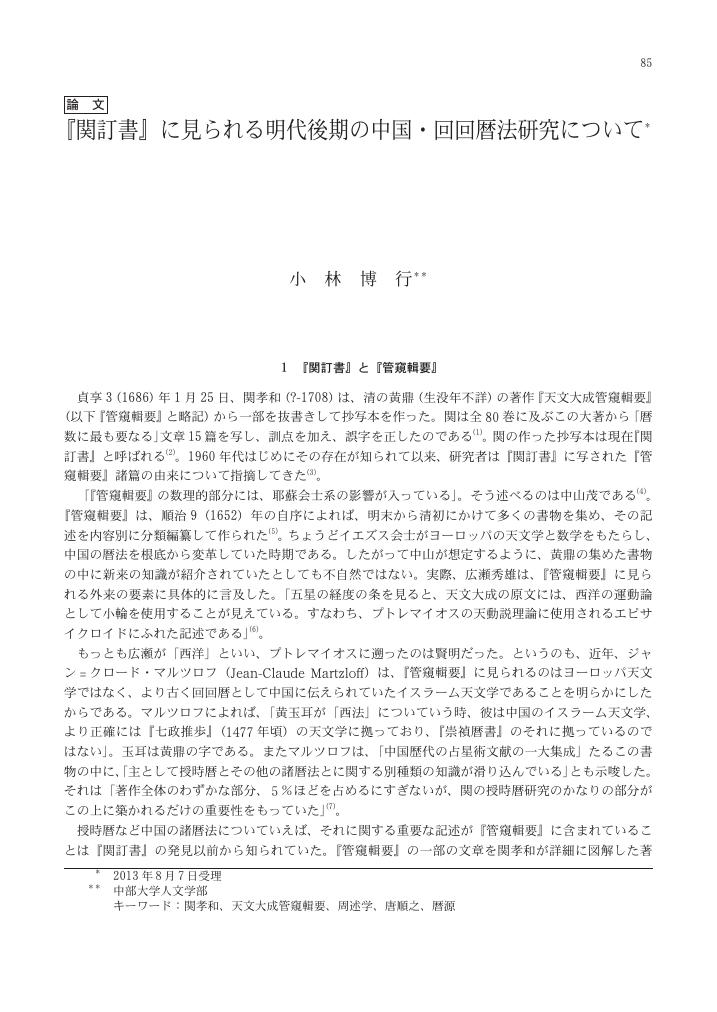1 0 0 0 OA シンポジウム 全相運先生追悼シンポジウム : 「韓国」科学技術史を再考する
- 著者
- 塚原東吾 槇蒼健 宮島一彦 全勇勲 宮川卓也 武田時昌 金凡性
- 出版者
- 日本科学史学会
- 雑誌
- 科学史研究 (ISSN:21887535)
- 巻号頁・発行日
- vol.57, no.287, pp.211-221, 2018 (Released:2021-01-24)
1 0 0 0 OA 科学史入門 体外受精-胚移植の導入と日本の不妊医療研究
- 著者
- 由井 秀樹
- 出版者
- 日本科学史学会
- 雑誌
- 科学史研究 (ISSN:21887535)
- 巻号頁・発行日
- vol.57, no.287, pp.222-225, 2018 (Released:2021-01-24)
1 0 0 0 OA アゴラ 第25回科学史技術史国際会議(於リオデジャネイロ)報告
- 著者
- 木本 忠昭
- 出版者
- 日本科学史学会
- 雑誌
- 科学史研究 (ISSN:21887535)
- 巻号頁・発行日
- vol.56, no.283, pp.8, 2017 (Released:2021-01-10)
1 0 0 0 OA 科学史技術史の現在・過去・未来(III)
- 出版者
- 日本科学史学会
- 雑誌
- 科学史研究 (ISSN:21887535)
- 巻号頁・発行日
- vol.53, no.271, pp.273, 2014 (Released:2020-12-09)
1 0 0 0 OA 科学史技術史の現在・過去・未来(II)
- 出版者
- 日本科学史学会
- 雑誌
- 科学史研究 (ISSN:21887535)
- 巻号頁・発行日
- vol.53, no.270, pp.127, 2014 (Released:2020-12-09)
1 0 0 0 OA 『科学史研究』第III期刊行に当たって
- 出版者
- 日本科学史学会
- 雑誌
- 科学史研究 (ISSN:21887535)
- 巻号頁・発行日
- vol.53, no.269, pp.1-2, 2014 (Released:2020-12-09)
1 0 0 0 OA 『関訂書』に見られる明代後期の中国・回回暦法研究について
- 著者
- 小林 博行
- 出版者
- 日本科学史学会
- 雑誌
- 科学史研究 (ISSN:21887535)
- 巻号頁・発行日
- vol.53, no.269, pp.85-98, 2014 (Released:2020-12-09)
The Seki Teisyo (関訂書), a manuscript compiled by Seki Takakazu (関孝和) in 1686, is known to consist of 15 treatises which Seki extracted from an early Qing astronomical and astrological corpus, the Tianwen Dacheng Guankui Jiyao (天文大成管窺輯要). Containing a detailed account of the Shoushi Li (授時暦) as well as a comparative study of Chinese and Islamic calendrical systems, these treatises have drawn the attention not only of Seki but of modern historians. In this paper, I show that 14 of the 15 treatises Seki selected had been composed by a late Ming scholar, Zhou Shuxue (周述学), who discussed issues with Tang Shunzhi (唐順之). Their time predates the era in which the mathematical basis of the Shoushi Li was scrutinized and a new Chinese calendrical system was invented incorporating Western astronomical knowledge. I also mention some earlier works that Tang and Zhou could have consulted. Although Seki never knew the author of the treatises nor their background, his concern centered on themes that seem to have derived from one of those earlier works: the Liyuan (暦源).
- 著者
- 隠岐 さや香
- 出版者
- 日本科学史学会 ; 2014-
- 雑誌
- 科学史研究. [第Ⅲ期] = Journal of history of science, Japan. 日本科学史学会 編 (ISSN:21887535)
- 巻号頁・発行日
- no.295, pp.298-302, 2020-10
1 0 0 0 科学史入門 ソ連の物理学とイデオロギー
- 著者
- 金山 浩司
- 出版者
- 日本科学史学会
- 雑誌
- 科学史研究. [第Ⅲ期] = Journal of history of science, Japan. 日本科学史学会 編 (ISSN:21887535)
- 巻号頁・発行日
- no.272, pp.481-488, 2015-01
- 著者
- 伊藤 憲二
- 出版者
- 日本科学史学会 ; 2014-
- 雑誌
- 科学史研究. [第Ⅲ期] = Journal of history of science, Japan. 日本科学史学会 編 (ISSN:21887535)
- 巻号頁・発行日
- no.292, pp.344-355, 2020-01
- 著者
- 相馬 尚之
- 出版者
- 日本科学史学会 ; 2014-
- 雑誌
- 科学史研究. [第Ⅲ期] = Journal of history of science, Japan. 日本科学史学会 編 (ISSN:21887535)
- 巻号頁・発行日
- no.291, pp.214-232, 2019-10
- 著者
- 法貴 遊
- 出版者
- 日本科学史学会 ; 2014-
- 雑誌
- 科学史研究. [第Ⅲ期] = Journal of history of science, Japan. 日本科学史学会 編 (ISSN:21887535)
- 巻号頁・発行日
- no.286, pp.84-99, 2018-07
- 著者
- 川合 大輔
- 出版者
- 日本科学史学会 ; 2014-
- 雑誌
- 科学史研究. [第Ⅲ期] = Journal of history of science, Japan. 日本科学史学会 編 (ISSN:21887535)
- 巻号頁・発行日
- no.283, pp.176-195, 2017-10
- 著者
- 春日 あゆか
- 出版者
- 日本科学史学会 ; 2014-
- 雑誌
- 科学史研究. [第Ⅲ期] = Journal of history of science, Japan. 日本科学史学会 編 (ISSN:21887535)
- 巻号頁・発行日
- no.278, pp.133-147, 2016-07
1 0 0 0 カイロ・ゲニザ文書における眼病の治療について
- 著者
- 法貴 遊
- 出版者
- 日本科学史学会
- 雑誌
- 科学史研究. [第III期] (ISSN:21887535)
- 巻号頁・発行日
- vol.54, no.274, pp.119-134, 2015-07-24
The present article explores practical aspects of medieval ophthalmology in Cairo Genizah, by examining an exchange of letters (T-S 10J16.16) between two ophthalmologists (Abu Zikri and Abu 'Ali). In this document, written between the twelfth and thirteenth century, they talked about conditions and treatments of three eye diseases, i.e. ulcer of cornea (qarha fi qarniya), conjunctivitis (ramad) and trachoma (jarab). I compare their descriptions with the explanations found in major Arabic ophthalmological texts, and thereby reveal the practical dimension of their medical activity. At the stage of diagnosis, Abu Zikri's observation was based on the same pathological knowledge as described in the medieval Arabic medical texts, which was also shared by Abu 'All. However, when deciding the treatment plans, the two ophthalmologists, though still basing themselves on the same medical books, adopted different methods. Finally, at the stage of prescription, Abu 'Ali suggested the use of some medical substances that could seldom be found in the major texts. His knowledge of pharmacotherapy could come from his experiences (tajriba). Although such empirical knowledge might not have affected Abu 'All's basic physiology, its accumulation within the domain of pharmacotherapy could have influenced his decision about treatment plans.
- 著者
- 北村 紗衣
- 出版者
- 日本科学史学会
- 雑誌
- 科学史研究. [第III期] (ISSN:21887535)
- 巻号頁・発行日
- no.269, pp.118-119, 2014-04-28
1 0 0 0 板倉聖宣監修, 『事典 日本の科学者-科学技術を築いた5000人』, 日外アソシエーツ, 2014年6月, 971頁, 17,000円+税, ISBN978-4-8169-2485-9
- 著者
- 多久和 俊明
- 出版者
- 日本科学史学会
- 雑誌
- 科学史研究. [第III期] (ISSN:21887535)
- 巻号頁・発行日
- vol.54, no.276, pp.397-400, 2016-01-25
- 著者
- 諫早 庸一
- 出版者
- 日本科学史学会
- 雑誌
- 科学史研究. [第Ⅲ期] = Journal of History of Scince, Japan. 日本科学史学会 編 (ISSN:21887535)
- 巻号頁・発行日
- no.269, pp.99-105, 2014-04
- 著者
- 諫早 庸一
- 出版者
- 日本科学史学会
- 雑誌
- 科学史研究. [第Ⅲ期] = Journal of History of Scince, Japan. 日本科学史学会 編 (ISSN:21887535)
- 巻号頁・発行日
- no.269, pp.99-105, 2014-04



